Spud Woodward, member of the South Atlantic Fishery Management Council and Atlantic States Marine Fisheries Commission, said managing maximum sustainable yield does not work for catch & release fisheries.
NMFS Holds First Recreational Fishing Economic Workshop in Nine Years
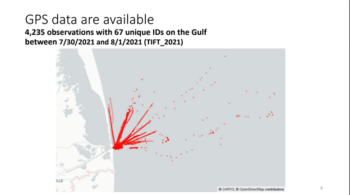
GPS data from 67 Gulf anglers tallied 4,235 observations on a three-day weekend. The chart demonstrates what is possible when using smartphone GPS data.
Why is fishing catch and effort data so important to recreational fishing economics?
First the obvious, we have the data and actual value of commercial fish catch to estimate the economic impact of commercial fishing, but we have relatively little data for recreational fishing. This lack of reliable data on the number of anglers fishing and what they catch has been challenging for the recreational fishing community.
Recreational fishing produces billions of dollars in impact on our economy each year. Developing tools that identify how many anglers are fishing, where they fish and what they are catching will help identify shifting stocks and other climate impacts as well as help determine economic impact.
The examples of recreational fishing economic data that we do have really highlight the importance of collecting this information. For example, a 2019 study commissioned by the McGraw Center for Conservation on striped bass from Maine to North Carolina found that the recreational striped bass fishery has a whopping $7.7 billion dollar impact on GDP and supports 104,876 jobs.
“The findings in this study are significant as changes to striped bass management policies can have significant impacts on coastal and state economies,” said Charles S. Potter Jr., President and CEO of the McGraw Center for Conservation Leadership. “Smart management plans depend in part on understanding how changes to the fishery can impact local commercial and recreation communities as well as the public at large.”
Another need for economic data on recreational fishing is the development of offshore wind farms. The recreational fishing community and offshore wind farm developers both have wanted science-based data on who fishes in a wind farm lease area, what they catch and the economic impact of that data. The information just does not exist today.
And lastly, we need to account for the number of anglers fishing and what they catch because it dramatically impacts our ability to manage fish stocks and fisheries to abundance. Climate change impacts on shifting stocks make this more important than ever before. We need better fishing data to determine and measure the impacts of climate on fish, fisheries and fishing communities.
On April 25 and 26, 2023, NOAA ran a hybrid online/in-person National Marine Fisheries Service (NMFS) Recreational Economic Constituent Workshop in Tampa, Florida to address these and other issues related to economics and recreational fishing.
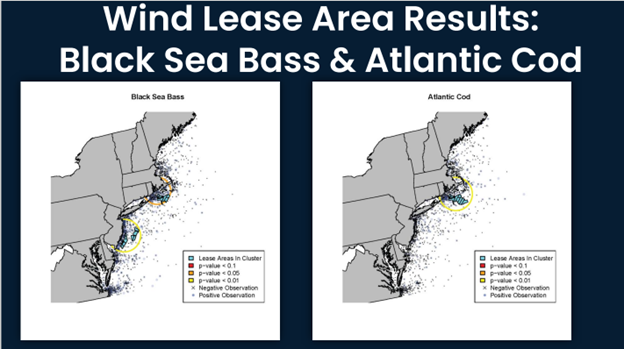
Fish Rules data (and eventually Fishbrain data) will be able to be used to identify what species anglers are targeting and where they are fishing. Like these charts on black sea bass and cod.
Workshop Purpose
Hats off to NOAA for holding the workshop. About sixty people participated in the two-day workshop including representatives from private angling, charter fishing, bait & tackle shops, NOAA scientists/economists, fish managers, as well as fishing industry association leaders.
The aim of the workshop was to enhance the understanding of how economics plays a role in management decisions and identify information gaps; explore how stakeholders can improve recreational fishing economic data collection; and identify tangible ways anglers can help collect data and share information in the future.
Here are some workshop highlights.
Fish in the Water are Worth More than Fish Dead on the Dock
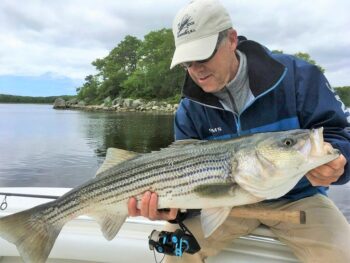
Peter Jenkins, chair of the American Saltwater Guides Association, said, “Growing fish to abundance makes great economic sense; more fish in the water for all of us to catch, eat and/or release.”
Highlights of the workshop included a brief presentation by Spud Woodward on angler perceptions on how recreational economic data needs to change and be enhanced.
Mr. Woodward, a retired Georgia Department of Natural Resources employee, member of the South Atlantic Fishery Management Council and Atlantic States Marine Fisheries Commission, said, “We manage fisheries to maximum sustainable yield (MSY); however, this practice does not work for the recreational fishing community as many anglers practice catch & release, and the fish released are not properly being accounted for.”
Participants shared that the potential of catching fish is what drives recreational fishing, so a fish released back into the water for other anglers to catch is worth a lot more than a fish caught and killed.
Peter Jenkins, owner of the Saltwater Edge outfitters in Middletown, RI and chairman of the board of the American Saltwater Guides Association, advocates for abundant fisheries. Jenkins said in an interview, “Access to abundant fisheries is critical to our business and directly relates to economics. The idea is to grow fish to abundance so there are more of them in the water for all of us to catch, eat and/or release.”
Future economic data collected and analyzed should identify the value of fish caught and released as this is not presently being reflected.
Climate Impacts on Fisheries
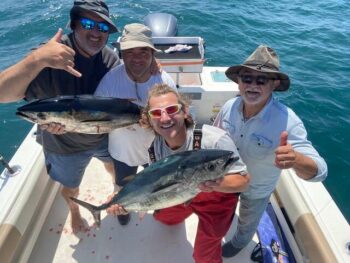
Anglers with bluefin they caught close to shore. It was the first time they had fished for bluefin tuna. Climate change continues to put pressure on species arriving and those leaving an area.
At the 2022 University of Rhode Island Graduate School of Oceanography Baird Symposium on climate impacts on recreational fishing, anglers shared the climate impacts they were seeing on the water.
One key learning shared by anglers was that warm water has brought robust bait profiles into the Northeast, including squid, silversides, all types of herring and mackerel, Atlantic menhaden and peanut bunker, sand eels, etc. Anglers said they were here before but not in this abundance all at the same time. Warm water has brought abundant bait, which in turn is attracting an abundance of warm water fish, as cold-water fish such as winter flounder and American lobster leave the area.
Fish in greater abundance today include scup, black sea bass, sea robins, as well as pelagic and exotic warm water fish such as cobia, mahi and tuna. Striped bass are prolonging their stay, while large pelagic fish and a variety of whales and sharks have also been closer to shore than ever before.
Last year on one day, September 11, anglers caught more than 24 giant bluefin tuna – from 400 to 700 pounds each – one to three miles off Narragansett and Newport, RI beaches. Dolphin pods of 200 to 300 were in the mouth of Narragansett Bay during the summer in 2020, 2021 and 2022, which anglers had not seen in great numbers before. In March 2023, a small pod was in Mt. Hope Bay on the Massachusetts/Rhode Island line. Sharks are being caught close to shore too. All of this was attributed to the warm water and enhanced bait profiles that attracted fish to come close to shore.
For the past two years anglers who never targeted school bluefin tuna ran out and purchased tuna fishing gear and often caught fish on their first outing. The impact of anglers catching tuna in new geographic areas could have detrimental impacts on the health of the fishery. It may also have a positive impact on the local economy where the fish traveled to and a negative impact on the geographic place the fish left.
It’s important to make sure we have new economic data that reflects current situations as new fisheries are emerging and old ones are leaving due to climate change. This type of activity is happening in many places throughout the coastal United States.
How New Data Sources are Working to Enhance Economics
Richard Woodward of Texas A & M University shared how GPS smartphone data is being used to identify where anglers fish and how often.
Woodward said at the workshop, “What I mean by electronic data is granular data gathered in real time about angler behavior and choices. I am focusing on data gathered using a smartphone. It could be in the form of survey on a smartphone (iSnapper), data gathered passively while using an app (FishVerify), or location data gathered without specific angler interaction or complete knowledge.” You can see sample smartphone data plots on anglers in the Gulf of Mexico from Woodward’s presentation.
In another recreational fishing electronic data study, Scott Steinback from NMFS Northeast Fisheries Science Center and Albrey Arrington of Fish Rules and Fishbrain, which are both smartphone software applications for anglers, shared how social media data on recreational fishing is being used to identify what anglers catch and where.
The aim of the study was to use Fish Rules georeferenced search data to understand the spatial distribution of private recreational fishing for area management, marine spatial planning, offshore wind energy and offshore aquaculture development.
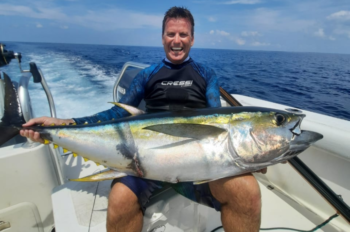
Albrey Arrington said, “Fish Rules and Fishbrain create a pot of gold of data that can be used to identify where anglers fish and what they are catching.”
The study scanned for clusters of species regulation views in Fish Rules, then assessed the relations between the Fish Rules clusters and known fishing locations obtained from for-hire logbook data, and then compared the species cluster against wind lease areas.
The study of 11 cluster areas and eight species suggests that Fish Rules can be used to identify species-specific fishing locations and in 26 wind lease areas identified in the Northeast, all but four overlap the Fish Rules clusters to some degree.
The study did not reveal the actual number of anglers fishing in lease areas, exactly what they caught nor the economic value of the catch, but this is a very good start with some good next steps in place to expand the concept. You can see the Steinbeck/Arrington presentation here.
Albrey Arrington said, “Fish Rules and Fishbrain create a pot of gold of data that can be used to identify where anglers fish and what they are catching.”
Immediate Applications and Next Steps
New electronic data gathering methods are important to continue to explore. As we engage in new efforts, however, we need to consider how the data supplements or complements the Marine Recreational Information Program (MRIP) data we presently use to estimate recreational fishing catch and effort. There needs to be a glidepath, a short term and long-term strategy to supplement existing data and/or to eventually transition to new methods.
Doug Lipton, NOAA’s chief economist for NMFS said, “I believe electronic data and gathering methods discussed at the workshop can help identify climate impacts on recreational fishing as well as who fishes in offshore wind farm areas.”
I agree, we need new methods like electronic data gathering by anglers to get a real time assessment of climate impacts on fish stocks. I believe that recreational fishing and offshore wind developers would welcome and benefit from scientific data on who fishes in a wind farm lease area, what they catch and the economic value of the catch activity.
A Workshop report is expected to soon be posted on NOAA’s website. The Workshop agenda and presentations can be found at National Marine Fisheries Service (NMFS) Recreational Economic Constituent Workshop.

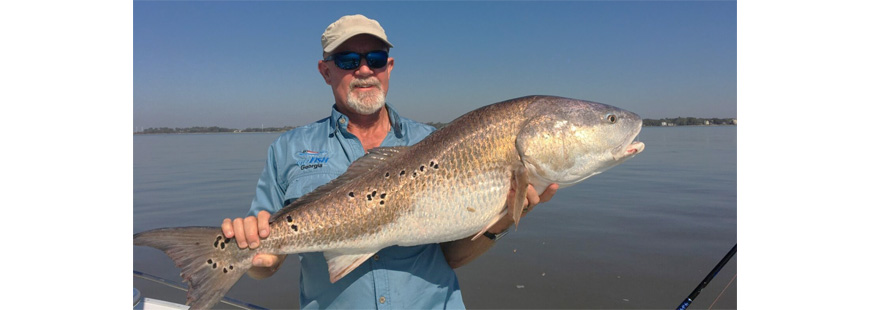
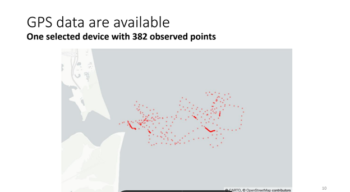
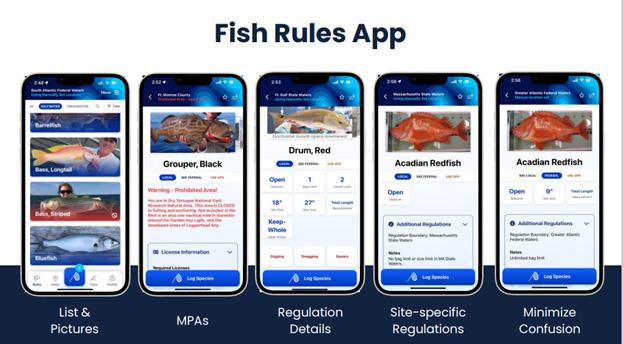

Pingback: Climate change could critically harm $253 billion US fishing industry, experts tell senators - Toymonkey News
Pingback: Climate change could critically harm $253 billion US fishing industry, experts tell senators – Green Reporter